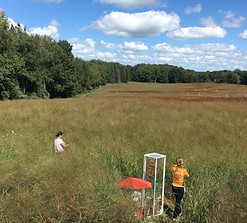Yuan Liu (Ph.D.)
1. Plant- soil- microbe interactions in perennial bioenergy cropping systems
1.1 Tracking the transfer of photosynthesized carbon through the plant-microbe-soil continuum with 13CO2 pulse-chase


We are using in situ 13C pulse chase methods to understand how the rhizosphere microbiome in perennial bioenergy cropping systems, switchgrass (Panicum virginitum var. Cave-In-Rock) in marginal lands acquires C resources from plants vs SOM to fuel N transformations and how newly photosynthesized C pass through the plant-soil-microbe continuum and contribute to SOM formation.
1.2 Root exudates shift how N mineralization and N fixation contribute to plant N supply in marginal lands soils
-
Using laboratory incubation methods, we found that different root exudates regulate N transformations processes through different mechanisms:
-
Carbohydrates addition increased soil N fixation relative to N mineralization.
-
Organic acids addition increased soil N mineralization relative to N fixation.
-
Organic acids addition significantly increased DON in Lake City soils.
-
Legacy of N addition had no effects on either N mineralization or N fixation.
-
Changes in soil pH and DON drive the change of N availability.

2. Soil organic matter (SOM) formation and stabilization mechanisms

-
Through an global synthesis, we generate, for the first time, global distribution maps of microbial necromass carbon (C) and nitrogen (N) and contributions to SOM in topsoil and subsoil.
-
Globally, necromass concentrations varied widely across ecosystems and by latitude, contributing 19-60% to SOC and 41-92% to soil N stocks, with particularly large accumulations in boreal and tropical ecosystems.
-
On average, fungal necromass contributions to SOM are 3x greater than bacterial, although this varied across ecosystems.
-
Microbial necromass contributions to SOC are strongly associated with soil C:N ratios and pH; necromass contributions are greater in soils with narrow C:N ratios and higher pH.
-
Microbial necromass is on average 23 and 77 times greater than living microbial biomass in topsoil and subsoil, respectively. link
3. Temperature response of SOM decomposition
Research 1: A new incubation and measurement approach to estimate the temperature response of soil organic matter decomposition link

-
We summarized two commonly used approaches for estimation of Q10.
-
We provide a new approach with rapid and automatic measurements for estimating Q10.
-
We compared the performance of three approaches using a laboratory experiment.
-
Traditional approaches underestimate Q10, especially in short time incubation.
-
The new approach performed better in estimating Q10 with high accuracy.
Research 2: The optimum temperature of soil microbial respiration: Patterns and controls link


-
We investigated the optimum temperature (Topt) of SOM decomposition.
-
Topt ranged from 38.5 to 46.0 °C in 25 forest soils, with an average of 42.4 °C.
-
Topt increased significantly with increasing latitude.
-
Climate, substrate and soil microorganism regulate the regional variation in Topt.
-
The latitudinal variation of Topt should be considered in model optimization.
Research 3: Regional variation in the temperature sensitivity of soil organic matter decomposition in China's forests and grasslands link

-
We investigated the regional variation of Q10 in different forests and grasslands in China.
-
Q10 ranging from 1.16 to 3.19 (mean 1.63).
-
Q10 significantly increased with increasing altitude and decreased with increasing longitude.
-
pH and soil electrical conductivity primarily explained spatial variation in Q10.
Research 4: A global synthesis of rate and temperature sensitivity of soil nitrogen mineralization: latitudinal patterns and mechanisms link

-
Through an global synthesis, we investigated the variation in rate and Q10 of soil nitrogen mineralization (Nmin).
-
Nmin significantly increased with increasing latitude with an average of 2.41 mg N soil kg−1 day−1.
-
Q10 varied significantly among different ecosystems highest, with the highest found in forest soils (2.43) and the lowest found for grassland soils (1.67).
-
Nmin was primarily affected by SOC, C:N ratio, and clay content.
-
Q10 was primarily influenced by the soil C:N ratio and soil pH. link
Research 5: Temperature sensitivity of soil microbial respiration in soils with lower substrate availability is enhanced more by labile carbon input link

-
We examined the effects of glucose addition on Q10 of soil respiration.
-
Glucose addition increased Q10 , especially for mid-latitude soil samples.
-
Q10 in soils with lower substrate availability is enhanced more by glucose addition.